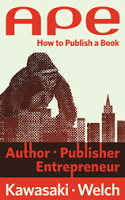How to Avoid the Self-Published Look - Part 3
Gaffes
The fourth sign of self-publishing is
gaffes-unintentional mistakes that cause embarrassment. It's easy for
self-publishers to make these gaffes because editing, particularly copyediting,
is a different skill from writing. Here are the most common gaffes:
* Widows. Three
main types of widows exist. (1) Widowed text is when the last line of a
paragraph appears on the following page or in the next column. (2) A widowed
heading occurs when a heading is on one page and the following text is on the
next page or in the next column. (3) A widowed bullet occurs when one bullet is
on a page and the subsequent bullets are on the next page or in the next
column.

* Orphans. There
are three kinds of orphans: (1) The first line of text in a paragraph is
separated from the rest of the paragraph on the following page or next column;
(2) A word or part of a word that is not long enough to clear the indent of the
following paragraph is by itself on the last line of a paragraph (usually any
word less than four characters); (3) Your book after your traditional publisher
has given up on it, but I digress.
Widows and orphans are unavoidable in ebooks
because people can adjust the font size and this changes the page layout. Don't
focus on these issues for your ebooks, but if you print your book on paper or a
static PDF, you must pay attention to them.
* Passive voice. The
passive voice is weak, vague, and wordy. "New York publishers are being
attacked by self-publishers" is not as powerful as "Self-publishers
are attacking New York publishers." I search for every instance of
"be" and "being" to eliminate as many instances of the
passive voice as I can. Word's grammar checker can also help you spot passive
sentences.
* Lack of consistency. Ensure
that the voice and design elements of your book are consistent. Here are three
examples. First, as we mentioned earlier, in this book "I" always
refers to me, Guy. Shawn is always mentioned in the third person.
"We" refers to our combined opinion and expertise.
Second, bulleted lists should maintain a parallel structure. If one starts with
a noun, they should all start with a noun. If one starts with a verb, they
should all start with a verb.
Third, consistency also applies to design. For example, in the print version of APE,
when a new section starts, the section title is always on the
next right-hand page, even if this creates a blank page to the left. Similarly,
the first chapter after a new section always starts on the next
right-hand page, always leaving the page on the back of the
section title blank.
* Excessive adjectives and
adverbs. These forms of speech are often overrated, overused, and vague.
How dark was the night? So dark that you couldn't see your hand in front of
your face? How slowly did he walk? Perhaps a toddler could move faster? How
much did you really miss your mother? Maybe enough to make you cry at night?
Find more concrete ways to describe things.
Metaphors and similes beat the crap out of adjectives and adverbs, so use them
when you can. For example, rather than saying, "Hockey is very
violent," you could say, "Hockey is war on ice."
* Lack of guideposts. This
recommendation and the next one are for nonfiction writers. Use subheads to
help your readers navigate sections of a chapter. The name of the chapter is
not enough in nonfiction books because so much material is in each chapter.
Real authors use subheads.
* Long passages of text. A
bulleted list (like this one) is a sign of an organized mind. Rather than
making your reader dig through long passages of text, use bulleted lists to
highlight what is most important. Lists also make great back cover copy for
your printed versions.
A great book that explains these kinds of gaffes and more is The Mac Is
Not a Typewriter by my lovely friend Robin Williams. Also, you can't
go wrong with The Chicago Manual of Style, and the Purdue Online
Writing Lab http://owl.english.purdue.edu/owl/.

Guy Kawasaki has written 12
books, 10 of which were traditionally published. His newest book is APE:
Author, Publisher, Entrepreneur - How to Publish a Book, which helps people
understand how and why to self-publish.
APE: Author, Publisher, Entrepreneur - How to Publish a Book, by Guy Kawasaki
and Shawn Welch, is available as an eBook ($9.99) and in paperback ($24.99).
Visit http://apethebook.com/








Published on October 13, 2013 18:05
No comments have been added yet.



